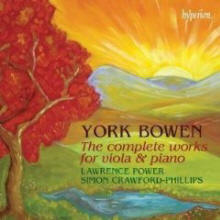|
You are reading the older HTML site Positive Feedback ISSUE july/august 2008
Notes
of an Amateur - July, 2008, Part 1
York Bowen, The Complete Works for Viola and Piano. Lawrence Power, viola; Simon Crawford-Phillips, piano. Hyperion CDA 67651/2. (2 CD) It is interesting to wonder whether the revival of music by early twentieth century composers who saw no reason to adopt modern musical style represents reappraisal or marketing acumen. Is a composer like England's York Bowen better than we have thought, blinded as so many of us are by the modernist idiom? Or is he just easier for a sentimental audience to listen to? Yes and yes. The music Bowen wrote prior to 1906 is pleasant, fairly generic late nineteenth century stuff that goes down easy, leaving little or no trace of itself in our minds. But the music written after 1906, while not deserting its genre, draws us in more than we expect, asking us to look again into its largely abandoned way of musical being. And the unique voice of the viola, which is barely noticeable in the earlier work, after 1906 becomes a powerful musical character, slightly darkening and enriching the music written expressly for it. The Sonata No. 2 (1906) is an interesting case. It seems almost like a piece of salon music (or background for a melodramatic film), music that as matter to listen to rather do others things to, is nearly unthinkable. But as we listen more attentively and begin to adjust to its style, it is clear that it is also something more than that. And this may be the key to the urge to revive Bowen. This sonata, without becoming something essentially other than what it is, makes that what more interesting. And here again, the viola is an essential part of the work's success. In the second movement, which begins with a section marked 'grave,' both the husky low range of the instrument and its reedy high range contribute to our sense that something thoughtful is going on in the face of the sentimental statement we expect from this 'kind' of music. We are being told that this kind of music is not so limited as we thought. The Romance (1908) and Allegro de Concert (1906) are also surprisingly compelling music. And the Phantasy in F Major (1918) and elegiac Melody for the G String (1917) and Melody for the C String (1918) are even stronger. Rhapsody in G Minor, written in 1955 when the composer was seventy-one, makes it clear that Bowen listened to the new music around him. It is more stylistically (and so emotionally) complex. But it is still unapologetically 'old' music. Edwardian fiction of such long neglected writers as Arnold Bennett, a contemporary of Bowen's, has this same quality: it flies in the face of such modernist sophistication as Virginia Woolf's, insisting on the continuing power of the older, more rhetorical, emotionally fulsome way of story-telling. The practice of the arts (literature, music, the visual arts) did indeed change in the early twentieth century; but contrary to what Virginia Woolf said (to provide a case for her modernist writing?), human nature did not. And the ability of the music of York Bowen to reach us, once we've succeeded in setting aside our acquired modernist sensibilities, demonstrates that it did not change at the turn of the twenty-first either. Thanks for these fine recordings in no small part are due to two excellent performers and state of the art recorded sound. System used for this audition: Audio Note CDT3 transport and Dac 4.1 Balanced Signature, Blue Circle FtTH hybrid integrated amplifier, Jean Marie Reynaud Orfeo speakers. With Blue Circle BC6000 line conditioner. Audio Note Sogon and AN-Vx interconnects and Lexus speaker cable. Bob Neill, in addition to being an occasional equipment and regular music reviewer for Positive- Feedback Online, is also proprietor of Amherst Audio in Amherst, Massachusetts, which sells equipment from Audio Note, Blue Circle, Manley Labs, and JM Reynaud, among others.
|

